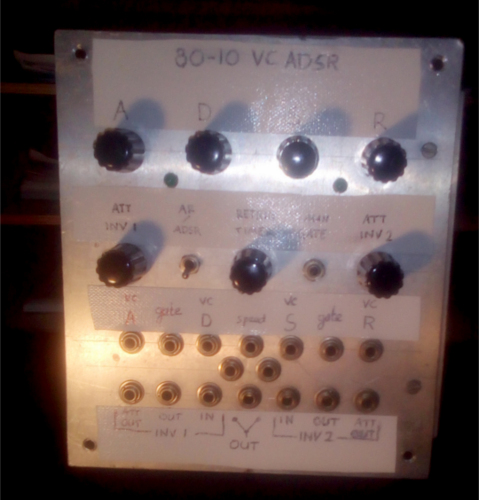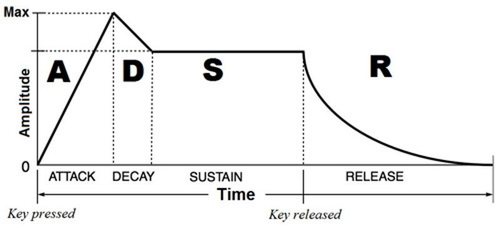80-10 VC Envelope Generator (ADSR)
The ADSR module in the Modular Beast is a Digisound 80-10 Voltage Controlled Envelope Generator. Its main function is generating an envelope upon manual or incoming gate signal, but it also has two built-in invertors.
Frontpanel
manual manual manual manual
attack decay sustain release
O O O O
attenuator AR/ADSR retrigger manual attenuator
invertor 1 switch timer gate invertor 2
O / O x O
voltage voltage voltage voltage voltage
control control control control control
attack gate 1 decay speed (TC) sustain gate 2 release
o o o o o o o
output output
o o
attenuated attenuated
output output input input output output
invertor 1 invertor 1 invertor 1 output invertor 2 invertor 2 invertor 2
o o o o o o o
ADSR
The module has 4 main parameters:
- Attack
- Decay
- Sustain
- Release
When a gate signal comes in, or when you hit the manual button, a signal will come out of the outputs that looks like so:
This signal can be used to drive, for instance, a voltage controlled amplifier, filter, or oscillator. It gives notes their initial punch (the Attack/Decay part), sets their stable volume (the Sustain), and controls how slowly they fade out after you release the key (the Release).
The Attack, Decay, Sustain, and Release parameters can be modified both by the manual knobs at the top of the module, but also using control voltage, at the CV inputs for ADSR at the top row of minijack inputs. Try adding a bit of LFO to the Sustain CV input to add some tremolo to your tones.
There is one control voltage input labelled 'speed', also referred to as TC in the original documentation. This controls the overall length of the cycle, so raising the voltage here results in a longer attack, decay, and release all at once.
Turning the retrigger timer knob controls the time after which the Attack-Decay cycle is retrigged, resulting in a second A/D peak after the first one. If the knob is turned fully counter-clockwise, no retriggering takes place.
Invertors
The module also contains two invertors. A signal going into one of the invertor inputs will result in a negative version of the same signal at the outputs (e.g., 3 volts in becomes -3 volts out, -2 volts in becomes 2 volts out, etc.). The most outward outputs can be attenuated with the attenuator knobs (the most outward knobs on the second row).
Inner working and caveats
The 80-10 is based on the CEM3310 IC. See the original documentation for the full schematics.
Adjustments were made to the gate and retriggering. A little piece of protoboard with some cludge including an IC socket, a resistor, and two diodes is hanging inbetween the switch and the retigger timer potmeter, possibly in an attempt to have the gate 2 input act as trigger input to allow external retriggering. Another theory is that an attempt at improving triggering with a Schmitt Trigger was made. Sadly, the patchwork doesn't seem to work particularly well and gate 2 is defunct.
Apart from fixing the gate/retrigger cludge, another possible improvement would be normalising the invertor inputs to the envelope output.


